Szilas A.P. Production and transport of oil and gas, Gathering and Transportation
Подождите немного. Документ загружается.

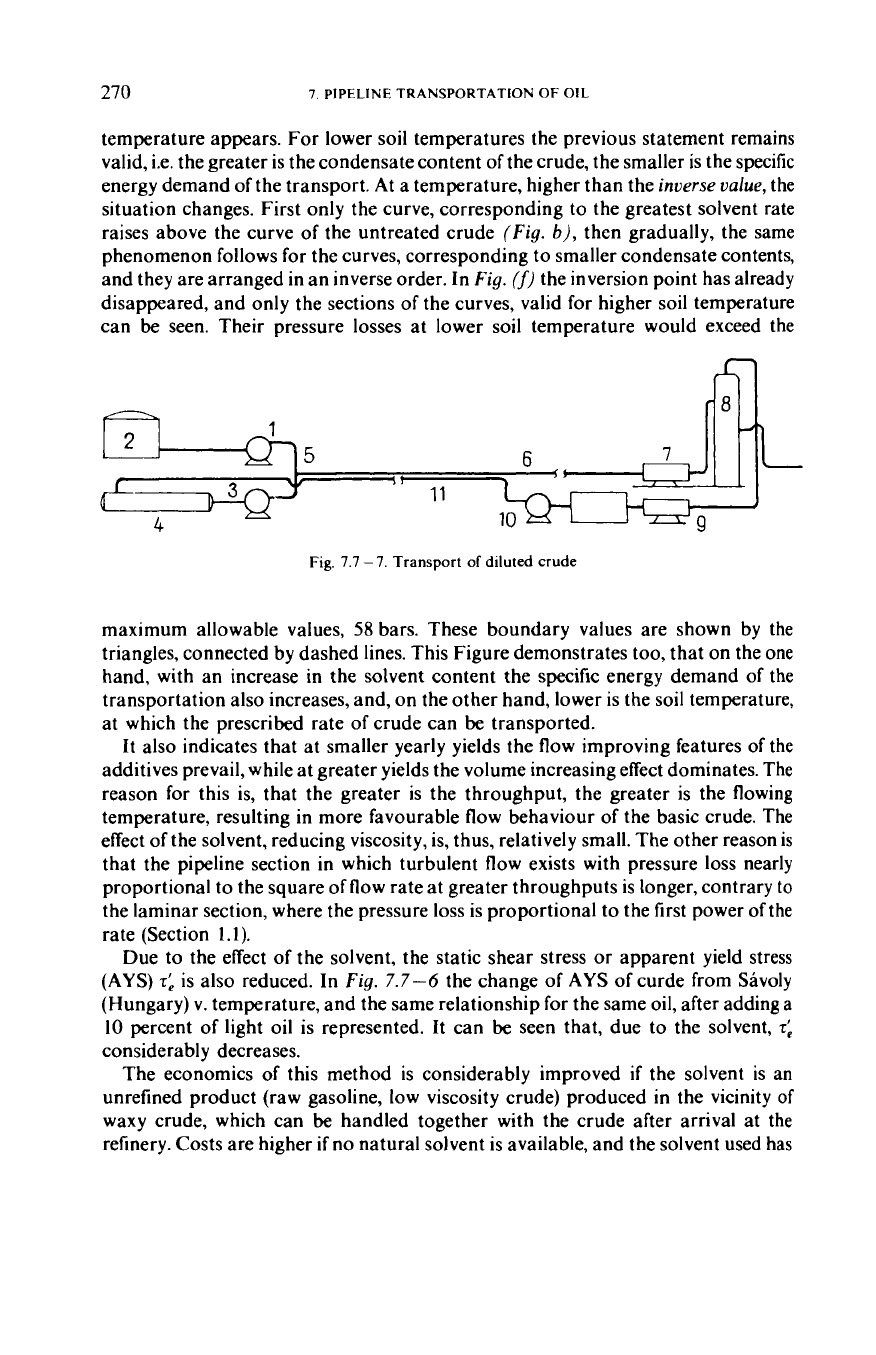
270
7.
PIPELINE TRANSPORTATION
OF
OIL
temperature appears. For lower soil temperatures the previous statement remains
valid, i.e. the greater is the condensate content of the crude, the smaller is the specific
energy demand
of
the transport. At a temperature, higher than the
inverse value,
the
situation changes. First only the curve, corresponding to the greatest solvent rate
raises above the curve of the untreated crude
(Fig.
b),
then gradually, the same
phenomenon follows for the curves, corresponding to smaller condensate contents,
and they are arranged in an inverse order. In
Fig.
(f)
the inversion point has already
disappeared, and only the sections
of
the curves, valid for higher soil temperature
can be seen. Their pressure losses at lower soil temperature would exceed the
Fig.
7.7
-
7.
Transport
of
diluted
crude
maximum allowable values,
58
bars. These boundary values are shown by the
triangles, connected by dashed lines. This Figure demonstrates too, that on the one
hand, with an increase in the solvent content the specific energy demand of the
transportation also increases, and, on the other hand, lower is the soil temperature,
at which the prescribed rate of crude can be transported.
It
also indicates that at smaller yearly yields the flow improving features of the
additives prevail, while at greater yields the volume increasing effect dominates. The
reason for this is, that the greater is the throughput, the greater is the flowing
temperature, resulting in more favourable flow behaviour of the basic crude. The
effect of the solvent, reducing viscosity, is, thus, relatively small. The other reason is
that the pipeline section in which turbulent flow exists with pressure loss nearly
proportional to the square of flow rate at greater throughputs is longer, contrary to
the laminar section, where the pressure
loss
is proportional to the first power of
the
rate (Section
1.1).
Due to the effect of the solvent, the static shear stress or apparent yield stress
(AYS)
zi
is also reduced. In
Fig.
7.7-6
the change of AYS of curde from Savoly
(Hungary) v. temperature, and the same relationship for the same oil, after adding a
10
percent of light oil is represented. It can be seen that, due to the solvent,
rb
considerably decreases.
The economics
of
this method is considerably improved
if
the solvent is an
unrefined product (raw gasoline, low viscosity crude) produced in the vicinity of
waxy crude, which can
be
handled together with the crude after arrival at the
refinery. Costs are higher
if
no natural solvent is available, and the solvent used has
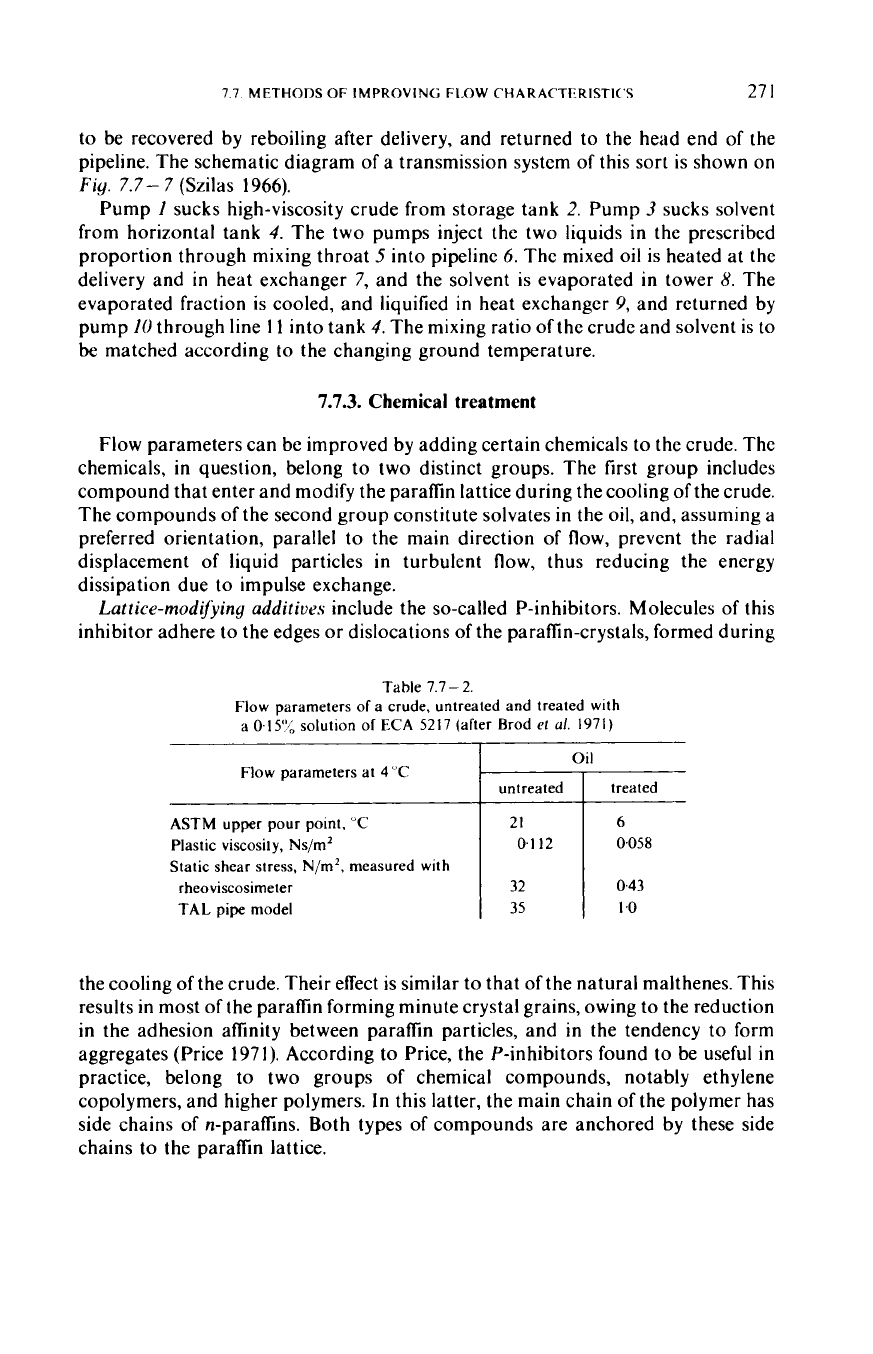
7.7.
METHODS
OF
IMPROVING
FLOW
CHARACTERISTICS
27
1
Flow
parameters at 4
“C
ASTM
upper pour point,
“C
Static shear stress,
N/mZ,
measured with
Plastic viscosity,
Ns/m2
rheoviscosimeter
TAL
pipe model
to
be recovered by reboiling after delivery, and returned to the head end of the
pipeline. The schematic diagram
of
a transmission system of this sort is shown on
Fig.
7.7-
7
(Szilas 1966).
Pump
I
sucks high-viscosity crude from storage tank
2.
Pump
3
sucks solvent
from horizontal tank
4.
The two pumps inject the two liquids in the prescribed
proportion through mixing throat
5
into pipeline
6.
The mixed oil is heated at the
delivery and
in
heat exchanger
7,
and the solvent is evaporated in tower
8.
The
evaporated fraction is cooled, and liquified in heat exchanger
9,
and returned by
pump
10
through line
I1
into tank
4.
The mixing ratio of the crude and solvent is to
be
matched according
to
the changing ground temperature.
Oil
untreated treated
21
6
0.1
12
0.058
32 0.43
35
I
.o
7.7.3.
Chemical treatment
Flow parameters can be improved by adding certain chemicals to the crude. The
chemicals, in question, belong to two distinct groups. The first group includes
compound that enter and modify the paraffin lattice during the cooling of the crude.
The compounds
of
the second group constitute solvates
in
the oil, and, assuming
a
preferred orientation, parallel to the main direction of flow, prevent the radial
displacement of liquid particles
in
turbulent flow, thus reducing the energy
dissipation due to impulse exchange.
Lattice-modijying
additives
include the so-called P-inhibitors. Molecules of this
inhibitor adhere to the edges or dislocations
of
the paraffin-crystals, formed during
Table
7.7
-
2.
Flow parameters
of
a crude, untreated and treated with
a O.I5‘’< solution
of
ECA
5217 (after Brod
el
(I/.
1971)
the cooling
of
the crude. Their effect is similar to that of the natural malthenes. This
results
in
most
of
the paraffin forming minute crystal grains, owing to the reduction
in the adhesion affinity between paraffin particles, and in the tendency to form
aggregates (Price 1971). According to Price, the P-inhibitors found to be useful in
practice, belong to two groups of chemical compounds, notably ethylene
copolymers, and higher polymers. In this latter, the main chain
of
the polymer has
side chains of n-paraffins. Both types of compounds are anchored by these side
chains to the paraffin lattice.

272
7.
PIPELINE TRANSPORTATION
OF
011,
'I
N/m2
6-
5-
Ofthe additives tried
out
in
European practice, the best known ones bear the code
designations ECA 841 and ECA 5217 (Brod
rt
ul.
1971). ECA
841
is a paste at room
temperature; it dissolves readily
in
aromatic solvents such as benzene, and its
homologues. ECA
521
7 is jelly, or paste-like at room temperature;
it
dissolves well
in these solvents,
too.
Both compounds are presumably esthers with metacrylate
type polymer chains attached to them. The effects of the two compounds were
investigated both in the laboratory and
in
the field.
Tuhle
7.7-2
shows that how the
flow behaviour of a
4
:
1
mixture of an African and Middle-East crude was modified
4-
3-
2-
-_T_)
k
002
003
004
005
c
,
%
Fig.
7.7-8. Influence
of
P-Inhibitor ECA
841
upon shear stress in
Algy6
crude
by the addition of0.15 percent ECA 5217. The improved properties, achieved by
the
additive were retained even after a storage period of 25 days in a tank.
The extent,
to
which flow properties are improved by the additives, depends
on
concentration and temperature.
Fig.
7.7-8
summarizes the results of experiments
with ECA 841, performed at the Petroleum Engineering Department of the Miskolc
Technical University for Heavy Industry (Hungary). The points, plotted, were
established for Algyo crude at 4
"C
temperature, and
32
s-
'
shear rate, using a
Haake rotary viscometer. The parameter is the temperature at which the inhibitor
was added. The shear stress at a given concentration of additive is seen
to
be the
less
(within the range of concentrations examined), the higher is the temperature of
addition. This is explained by the nature of the adsorption mechanism. The additive
is the more effective, the less the separated paraffin
in
the oil at the time when the
additive is added, and, hence, the smaller size the structures formed by the paraffin
crystals. The difference, in shear stress between 40 and
50"C,
is considerable.
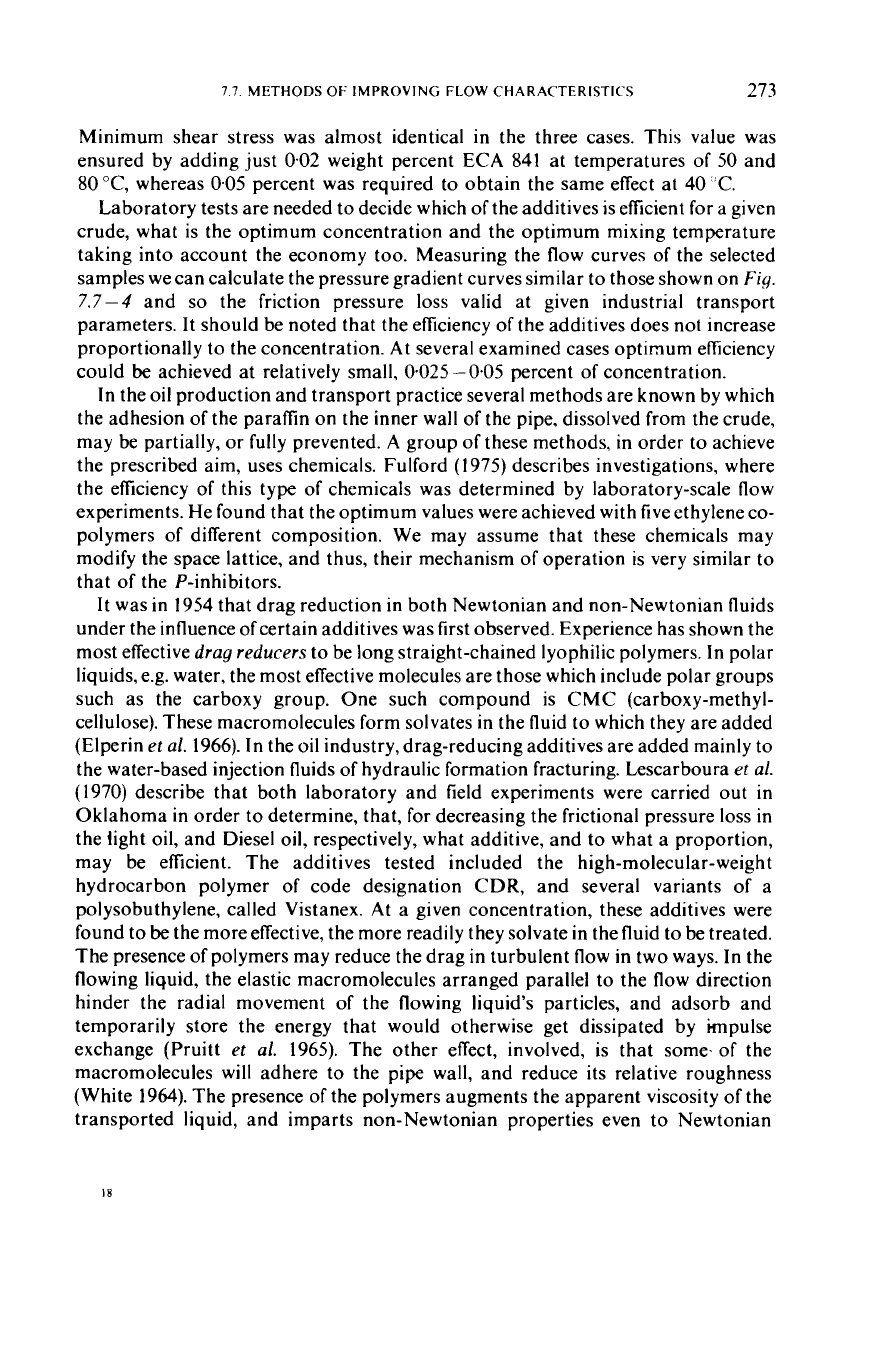
7
7
METHODS
OF
IMPROVING
FLOW
CHARACTERISTICS
273
Minimum shear stress was almost identical in the three cases. This value was
ensured by adding just
0.02
weight percent ECA 841 at temperatures of 50 and
80
"C, whereas 0.05 percent was required to obtain the same effect at
40
C.
Laboratory tests are needed to decide which of the additives is efficient for a given
crude, what is the optimum concentration and the optimum mixing temperature
taking into account the economy too. Measuring the flow curves of the selected
samples we can calculate the pressure gradient curves similar to those shown on
Fig.
7.7-4
and
so
the friction pressure
loss
valid at given industrial transport
parameters. It should be noted that the efficiency of the additives does not increase
proportionally to the concentration.
At
several examined cases optimum efficiency
could
be
achieved at relatively small, 0.025 -0.05 percent of concentration.
In the oil production and transport practice several methods are known by which
the adhesion of the paraffin on the inner wall of the pipe, dissolved from the crude,
may be partially,
or
fully prevented.
A
group of these methods, in order to achieve
the prescribed aim, uses chemicals. Fulford
(
1975) describes investigations, where
the efficiency of this type of chemicals was determined by laboratory-scale flow
experiments. He found that the optimum values were achieved with five ethylene co-
polymers of different composition. We may assume that these chemicals may
modify the space lattice, and thus, their mechanism of operation is very similar to
that of the P-inhibitors.
It was in 1954 that drag reduction in both Newtonian and non-Newtonian fluids
under the influence ofcertain additives was first observed. Experience has shown the
most effective
drag reducers
to
be long straight-chained lyophilic polymers. In polar
liquids, e.g. water, the most effective molecules are those which include polar groups
such as the carboxy group. One such compound is CMC (carboxy-methyl-
cellulose). These macromolecules form solvates in the fluid to which they are added
(Elperin
et
al.
1966).
In the
oil
industry, drag-reducing additives are added mainly to
the water-based injection fluids of hydraulic formation fracturing. Lescarboura
et
al.
(1970) describe that both laboratory and field experiments were carried out in
Oklahoma in order to determine, that, for decreasing the frictional pressure
loss
in
the light oil, and Diesel oil, respectively, what additive, and to what a proportion,
may be efficient. The additives tested included the high-molecular-weight
hydrocarbon polymer of code designation CDR, and several variants
of
a
polysobuthylene, called Vistanex.
At
a given concentration, these additives were
found to
be
the more effective, the more readily they solvate in the fluid to be treated.
The presence of polymers may reduce the drag in turbulent flow in two ways. In the
flowing liquid, the elastic macromolecules arranged parallel to the flow direction
hinder the radial movement of the flowing liquid's particles, and adsorb and
temporarily store the energy that would otherwise get dissipated by impulse
exchange (Pruitt
et
al.
1965).
The other effect, involved, is that some.of the
macromolecules will adhere to the pipe wall, and reduce its relative roughness
(White 1964). The presence of the polymers augments the apparent viscosity of the
transported liquid, and imparts non-Newtonian properties even to Newtonian
I8
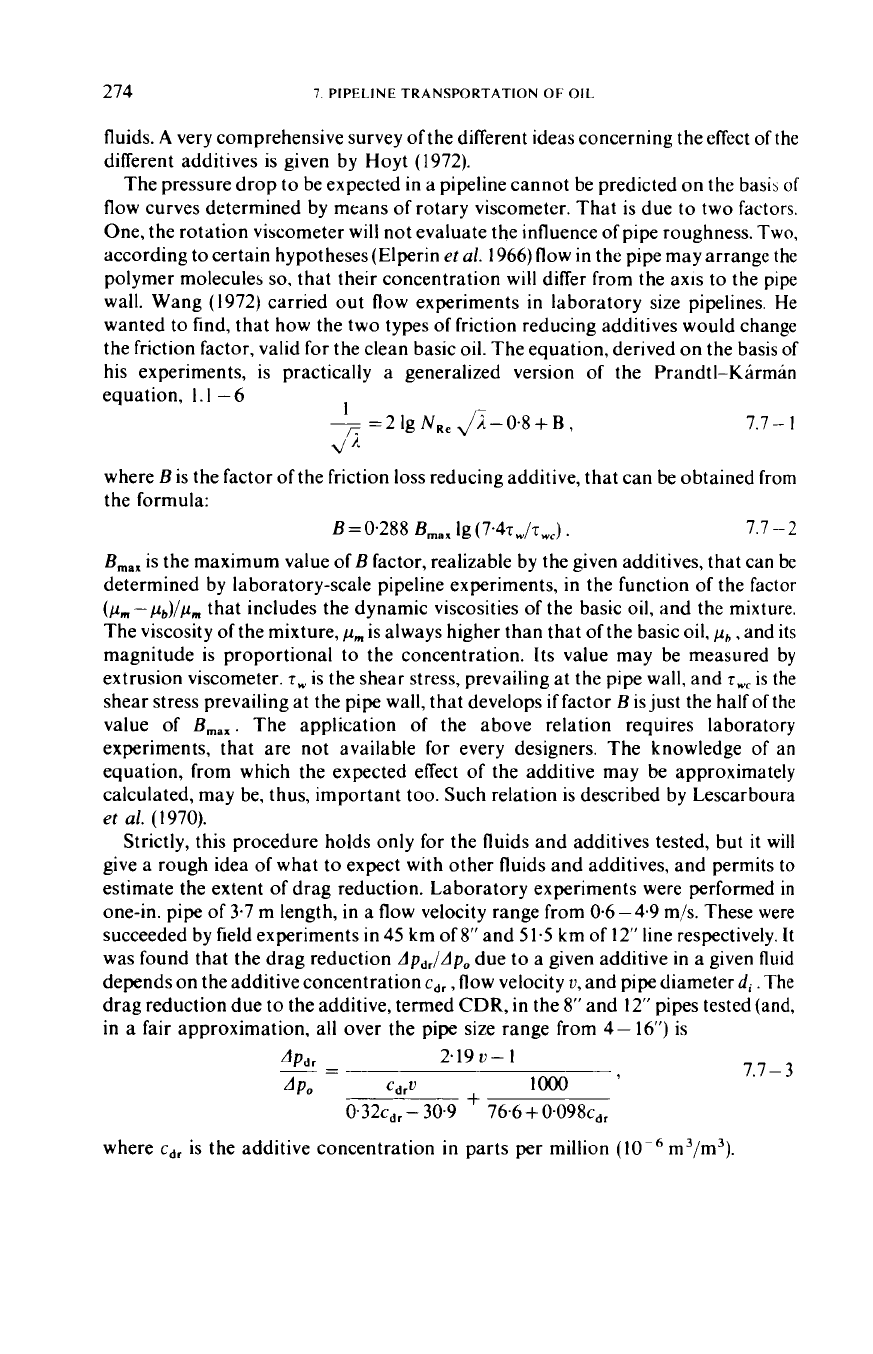
274
7.
PIPELINE TRANSPORTATION
OF. OIL
fluids.
A
very comprehensive survey of the different ideas concerning the effect of
the
different additives is given by Hoyt
(1972).
The pressure drop to be expected in a pipeline cannot be predicted on the basis
of
flow curves determined by means of rotary viscometer. That is due to two factors.
One, the rotation viscometer
will
not evaluate the influence of pipe roughness. Two,
according to certain hypotheses(E1perin
et
al.
1966)
flow
in
the pipe may arrange the
polymer molecules
so.
that their concentration will differ from the axis
to
the pipe
wall. Wang
(1972)
carried out flow experiments in laboratory size pipelines.
He
wanted
to
find, that how the two types of friction reducing additives would change
the friction factor, valid for the clean basic oil. The equation, derived on the basis
of
his experiments, is practically a generalized version of the Prandtl-Kirmin
equation,
1.
I
-
6
7.7-
I
where B is the factor of the friction loss reducing additive, that can be obtained from
the formula:
8=0’288
B,,,
Ig
(7’4T,,,/TWc).
7.7-2
B,,,
is the maximum value of B factor, realizable by the given additives, that can be
determined by laboratory-scale pipeline experiments, in the function of the factor
(p, -pb)/pm
that includes the dynamic viscosities of the basic oil, and the
mixture.
The viscosity of the mixture,
p,,,
is always higher than that of the basic oil,
p,,
,
and
its
magnitude is proportional to the concentration.
Its
value may be measured by
extrusion viscometer.
5,
is the shear stress, prevailing at the pipe wall, and
T,,
is
the
shear stress prevailing at the pipe wall, that develops
if
factor
B
is just the half of
the
value of
B,,,
.
The application of the above relation requires laboratory
experiments, that are not available for every designers. The knowledge of an
equation, from which the expected effect of the additive may be approximately
calculated, may be, thus, important too. Such relation is described by Lescarboura
et
al.
(1
970).
Strictly, this procedure holds only for the fluids and additives tested, but
it
will
give a rough idea of what to expect with other fluids and additives, and permits to
estimate the extent of drag reduction. Laboratory experiments were performed
in
one-in. pipe of
3.7
m length, in a flow velocity range from
0.6
-4.9
m/s. These were
succeeded by field experiments in
45
km of
8”
and
51.5
km of
12”
line respectively.
It
was found that the drag reduction
Apdr/Ap,
due to a given additive in a given fluid
depends on the additive concentration
cdr
,
flow velocity
u,
and pipe diameter
di
. The
drag reduction due to the additive, termed
CDR,
in
the
8”
and
12”
pipes tested (and,
in a fair approximation, all over the pipe size range from
4
-
16”)
is
1
~
=2
Ig
N,,
$-0.8+
B
,
45
‘Pdr
-
2.19
V-
1
APO
CdrV
-
lo00
’
+
032cdr
-
309
76.6
+
0.098~~~
where
Cdr
is the additive concentration in parts per million
(
m3/m3),
7.7
-
3

7.7.
METHODS
OF
IMPROVING
FLOW
CHARACTERISTICS 275
Example
7.7-
1.
Find the percent drag reductior! in light oil flowing at 2.3 m/s
velocity with CDR added in a proportion of
lo00
ppm. Equation 7.7
-
3 yields
2.19
x
2.3-
1
=
0.30
,
APdr
-
--
AD,
lo00
x
2.3
lo00
+
.”
0.32
x
1
OOO
-
30.9 76.6
+
0.098
x
1
o00
that is, drag reduction due to the additive amounts to 30 percent.
By Eq. 7.7-3, drag reduction increases with increasing flow velocity. The
maximum to be expected in practice is
50
-
60
percent. One thing to
be
given proper
attention in choosing an additive is that the “strength of the polymer molecule
must be sufficient, that is,
it
must not be degraded by the buffeting it receives in the
flowing liquid. Drag-reduction efficiency decreases as degradation proceeds.
7.7.4.
Oil
transport in
a
water
bed
A
fairly large number of the publications since 1950 have contained theoretical
considerations and experimental data concerning the common transport of oil and
water in the same pipeline. These publications assert
if
during flow the phase in
contact with the pipe is the water rather than the oil, and the oil remains enclosed in
0
02
04
0.6
08
-
qw
qow
Fig.
7.7
-9.
Power
to
dnve pure crude and crude
in
water
bed
v.
water content, after
M.
E.
Charles
a sort of water sheath, then the drag of flow and the driving power required may
be
significantly less even though the throughput is increased by the addition of the
water.
Figure
7.7-9, a plot of
M. E.
Charles’experimental data, shows the pressure
needed to pump the oil alone, referred to the pressure demand
of
the oil-water
mixture, v. the water content of the mixture (Szilas 1966). The pressure reduction
factor is seen
to
attain a maximum of about 9 for a water cut of 0.3-04. The
practical application
of
this idea was hampered by the fact that the two phases,
flowing together, tend to form highly unstable flow patterns:
it
was especially in
pipelines, laid over hilly terrain that the two phases were least likely to flow the way
they were expected to.
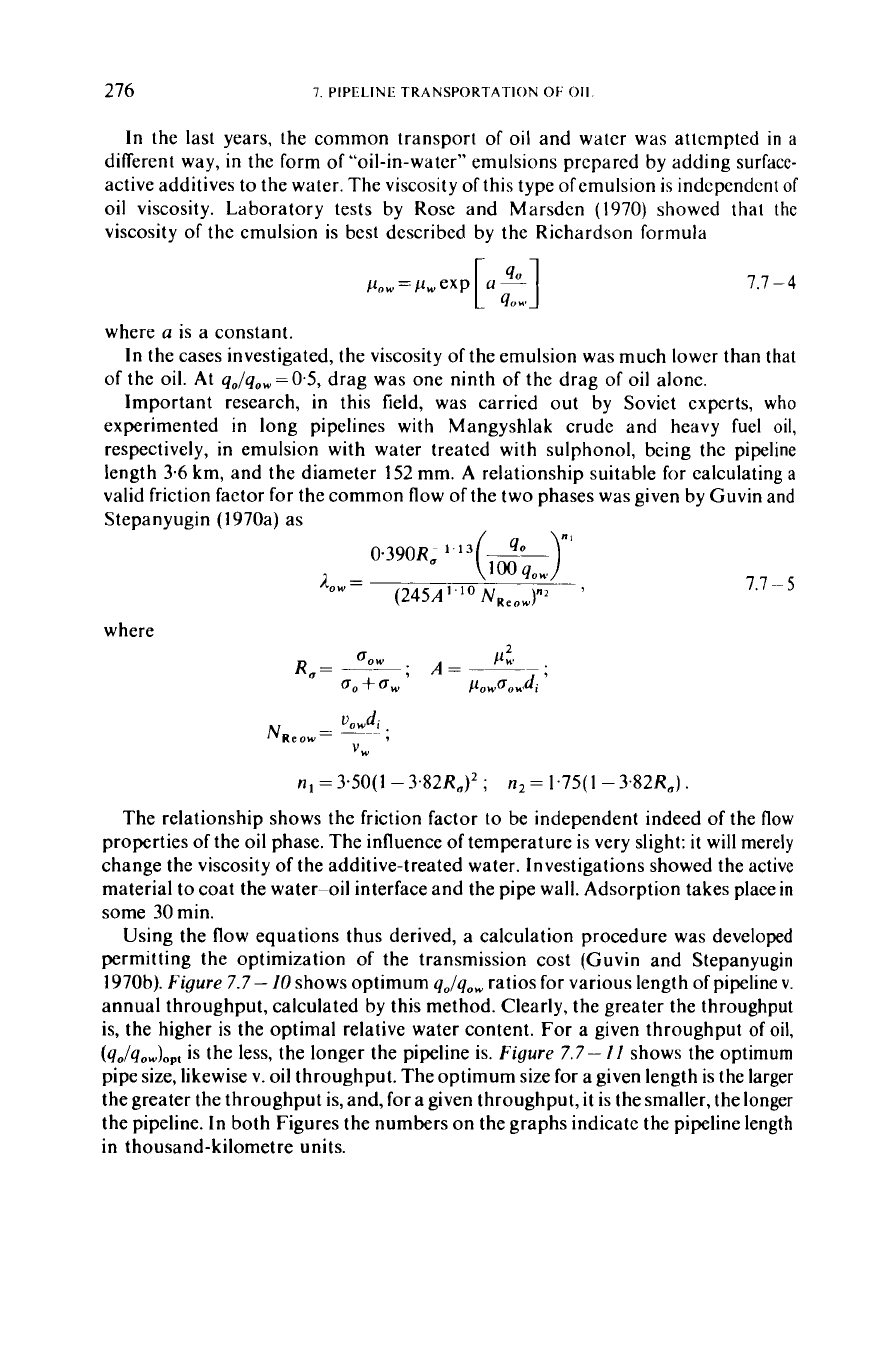
276
7.
PIPELINE
TRANSPORTATION
or..
011
In the last years, the common transport of oil and water was attempted
in
a
different way,
in
the form of "oil-in-water" emulsions prepared by adding surface-
active additives to the water. The viscosity of this type of emulsion is independent
of
oil viscosity. Laboratory tests by Rose and Marsden (1970) showed that
the
viscosity of the emulsion is best described by the Richardson formula
7.7
-4
where
a
is a constant.
In the cases investigated, the viscosity of the emulsion was much lower than
that
of the oil.
At
qo/qow=0.5, drag was one ninth of the drag of oil alone.
Important research,
in
this field, was carried out by Soviet experts, who
experimented in long pipelines with Mangyshlak crude and heavy fuel oil,
respectively,
in
emulsion with water treated with sulphonol, being the pipeline
length
36
km, and the diameter
152
mm.
A
relationship suitable for calculating
a
valid friction factor for the common flow of the two phases was given by Guvin and
Stepanyugin (l970a) as
7.1
-
5
where
The relationship shows the friction factor
to
be independent indeed of the flow
properties of the oil phase. The influence of temperature is very slight:
it
will merely
change the viscosity
of
the additive-treated water. Investigations showed the active
material to coat the water-oil interface and the pipe wall. Adsorption takes place
in
some
30
min.
Using the flow equations thus derived, a calculation procedure was developed
permitting the optimization of the transmission cost (Guvin and Stepanyugin
1970b).
Figure
7.7-
I0
shows optimum qo/qow ratios for various length of pipeline
v.
annual throughput, calculated by this method. Clearly, the greater the throughput
is, the higher
is
the optimal relative water content.
For
a given throughput of oil,
(qo/qow)op,
is the less, the longer the pipeline is.
Figure
7.7-
/I
shows the optimum
pipe size, likewise
v.
oil throughput. The optimum size for a given length is the larger
the greater the throughput is, and, for a given throughput,
it
is the smaller, the longer
the pipeline. In both Figures the numbers on the graphs indicate the pipeline length
in thousand-kilometre units.
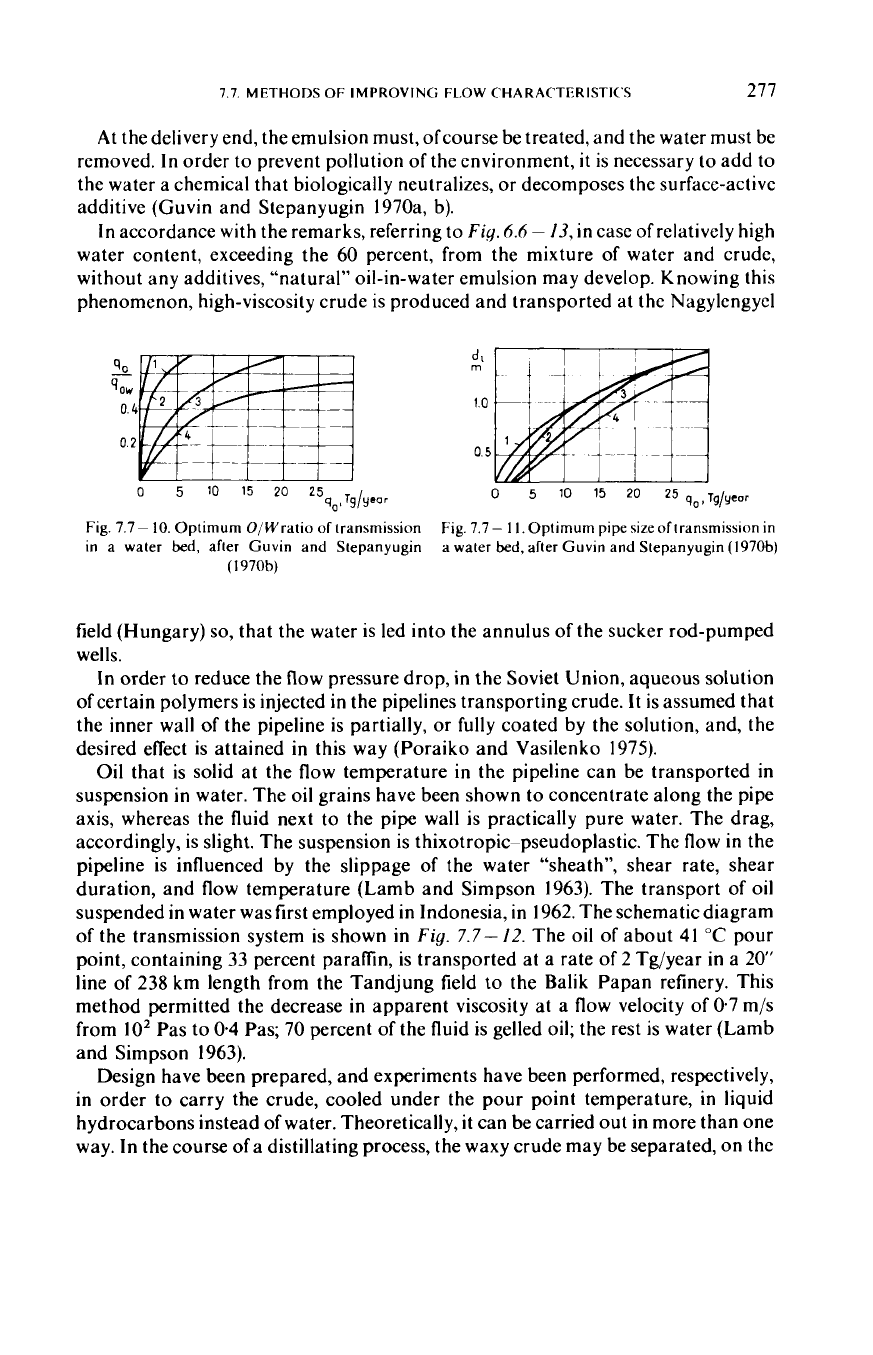
7.7.
METHODS
OF
IMPROVING
FLOW
CHARACTERISTICS
277
At
the delivery end, the emulsion must, ofcourse be treated, and the water must be
removed. In order to prevent pollution of the environment,
it
is necessary to add to
the water a chemical that biologically neutralizes,
or
decomposes the surface-active
additive (Guvin and Stepanyugin 1970a, b).
In accordance with the remarks, referring to
Fig.
6.6
-
13,
in case of relatively high
water content, exceeding the 60 percent, from the mixture of water and crude,
without any additives, “natural” oil-in-water emulsion may develop. Knowing this
phenomenon, high-viscosity crude is produced and transported at the Nagylcngyel
-
90
qow
04
02
0
5
lo
l5
*O
25
q,,,Tg/yeor
Fig.
7.7-
10.
Optimum OIWratio
of
transmission
in a water bed, after Guvin and Stepanyugin
(I
970b)
Fig.
7.7-
1
I.
Optimum pipe sizeoftransmission in
a water
bed,
after Guvin and Stepanyugin
(1970b)
field (Hungary)
so,
that the water is led into the annulus of the sucker rod-pumped
wells.
In order to reduce the flow pressure drop, in the Soviet Union, aqueous solution
of certain polymers is injected
in
the pipelines transporting crude.
It
is assumed that
the inner wall
of
the pipeline is partially,
or
fully coated by the solution, and, the
desired effect is attained in this way (Poraiko and Vasilenko 1975).
Oil
that is solid at the flow temperature in the pipeline can be transported in
suspension in water. The oil grains have been shown to concentrate along the pipe
axis, whereas the fluid next to the pipe wall is practically pure water. The drag,
accordingly, is slight. The suspension is
thixotropic-pseudoplastic.
The flow in the
pipeline is influenced by the slippage
of
the water “sheath”, shear rate, shear
duration, and flow temperature (Lamb and Simpson 1963). The transport
of
oil
suspended in water was first employed in Indonesia, in 1962. The schematic diagram
of the transmission system is shown in
Fig.
7.7-
f2.
The oil of about 41
“C
pour
point, containing 33 percent paraflin, is transported at a rate of 2 Tg/year
in
a 20’
line of 238 km length from the Tandjung field to the Balik Papan refinery. This
method permitted the decrease in apparent viscosity at a flow velocity of 07 m/s
from
10’
Pas to 0.4 Pas; 70 percent
of
the fluid is gelled oil; the rest is water (Lamb
and Simpson 1963).
Design have been prepared, and experiments have been performed, respectively,
in order to carry the crude, cooled under the pour point temperature,
in
liquid
hydrocarbons instead
of
water. Theoretically,
it
can be carried out in more than one
way. In the course
of
a distillating process, the waxy crude may be separated, on the
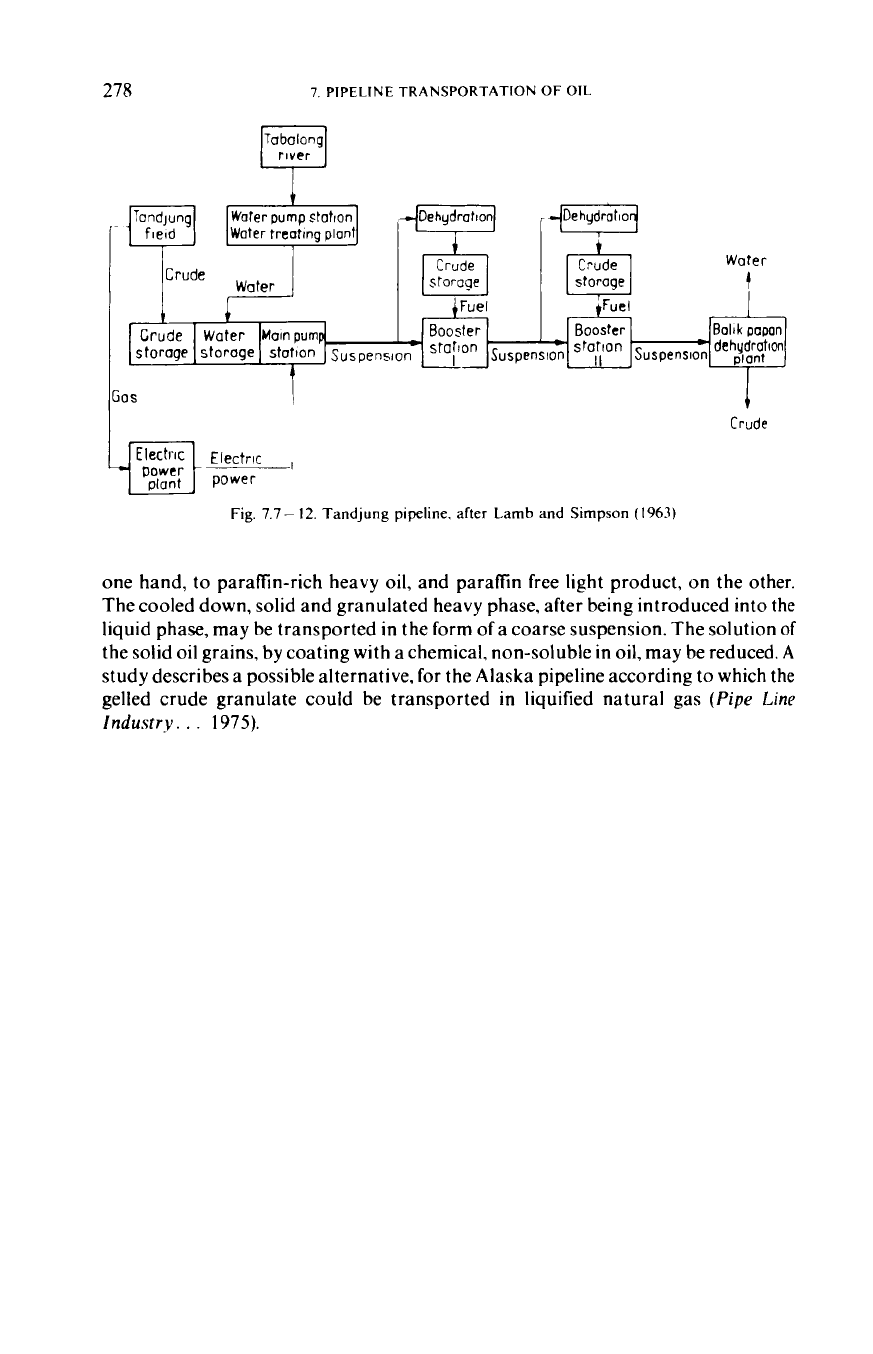
278
Booster
Booster Bolik
papan
7.
PIPELINE TRANSPORTATION
OF
OIL
pg
""."","'""""I
Water treating plant
Crude
Water
I
I
Dehydrotio
Crude Crude
Water
storage
f
i
Crude
Fig.
7.7-
12.
Tandjung pipeline. after Lamb and
Sirnpson
(1963)
one hand, to parafin-rich heavy oil, and parafin free
light
product, on the other.
The cooled down, solid and granulated heavy phase, after being introduced into
the
liquid phase, may be transported
in
the form of a coarse suspension. The solution of
the solid oil grains, by coating
with
a chemical, non-soluble
in
oil, may be reduced.
A
study describes a possible alternative, for the Alaska pipeline according to which
the
gelled crude granulate could be transported
in
liquified natural gas
(Pipe
Line
Industry.
.
.
1975).
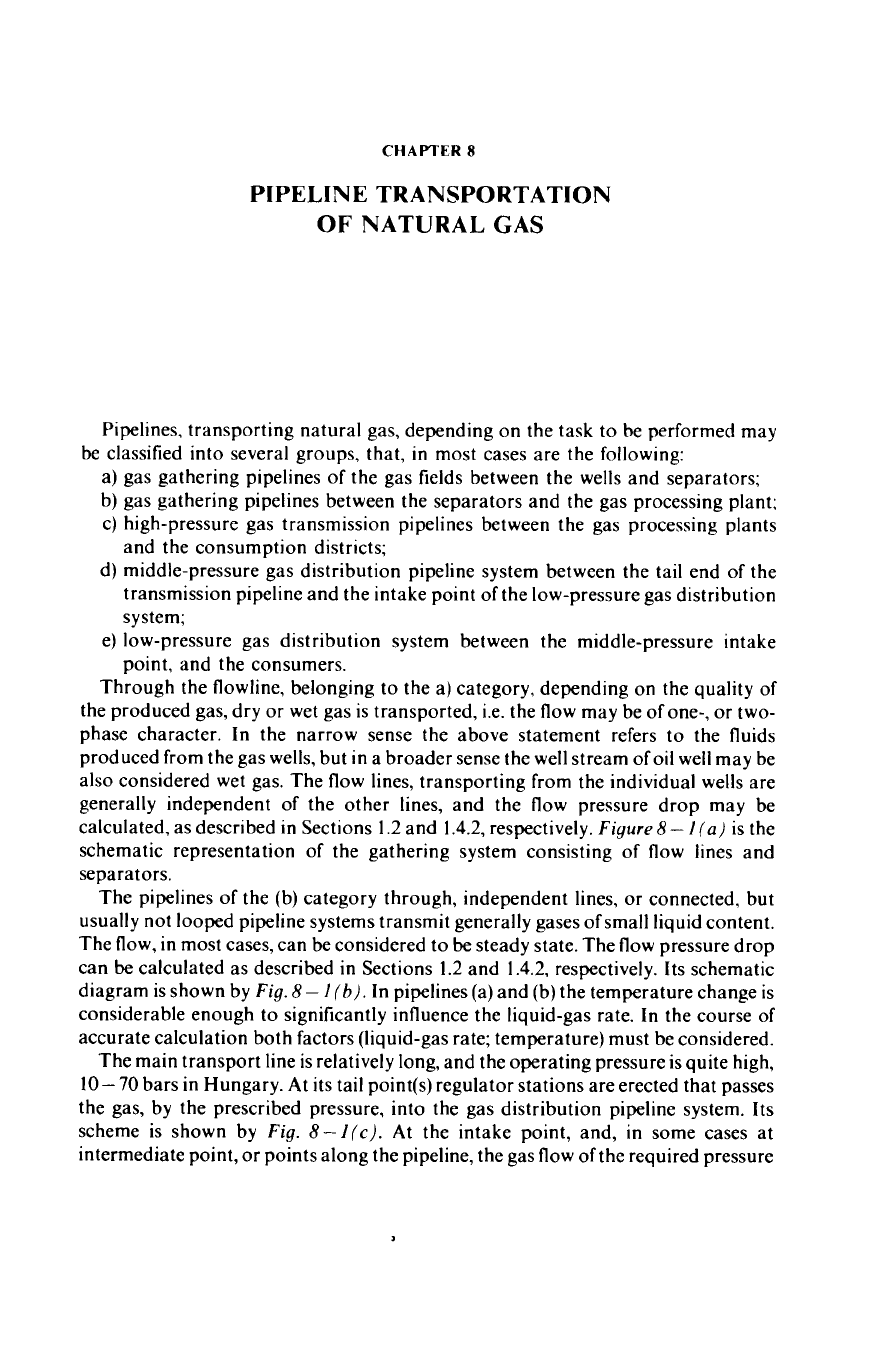
CHAPTER
8
PIPELINE TRANSPORTATION
OF
NATURAL GAS
Pipelines, transporting natural gas, depending on the task to be performed may
a) gas gathering pipelines of the gas fields between the wells and separators;
b) gas gathering pipelines between the separators and the gas processing plant;
c) high-pressure gas transmission pipelines between the gas processing plants
and the consumption districts;
d) middle-pressure gas distribution pipeline system between the tail end of the
transmission pipeline and the intake point of the low-pressure gas distribution
system;
e) low-pressure gas distribution system between the middle-pressure intake
point, and the consumers.
Through the flowline, belonging to the a) category, depending on the quality of
the produced gas, dry or wet gas is transported, i.e. the flow may be of one-, or two-
phase character. In the narrow sense the above statement refers to the fluids
produced from the gas wells, but in a broader sense the well stream ofoil well may be
also considered wet gas. The flow lines, transporting from the individual wells are
generally independent
of
the other lines, and the flow pressure drop may be
calculated, as described
in
Sections
1.2
and
1.4.2,
respectively.
Figure
8-
I
(a)
is the
schematic representation of the gathering system consisting of flow lines and
separators.
The pipelines of the (b) category through, independent lines, or connected, but
usually not looped pipeline systems transmit generally gases of small liquid content.
The flow, in most cases, can be considered to
be
steady state. The flow pressure drop
can
be
calculated as described in Sections
1.2
and
1.4.2,
respectively. Its schematic
diagram is shown by
Fig.
8
-
I
(h).
In pipelines (a) and (b) the temperature change is
considerable enough to significantly influence the liquid-gas rate. In the course of
accurate calculation both factors (liquid-gas rate; temperature) must be considered.
The main transport line is relatively long, and the operating pressure is quite high,
10-
70
bars in Hungary.
At
its tail point(s) regulator stations are erected that passes
the gas, by the prescribed pressure, into the gas distribution pipeline system. Its
scheme is shown by
Fig.
8-Ifc).
At the intake point, and, in some cases at
intermediate point, or points along the pipeline, the gas flow
of
the required pressure
be classified into several groups, that,
in
most cases are the following:
a
